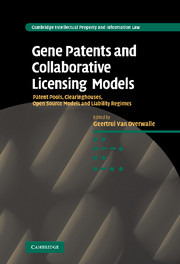 Gene Patents and Collaborative Licensing Models
Gene Patents and Collaborative Licensing Models Book contents
- Frontmatter
- Contents
- List of contributors
- Preface
- Foreword: Jean-Jacques Cassiman
- List of abbreviations
- Part I Patent pools
- 1 Patent pooling for gene-based diagnostic testing. Conceptual framework
- 2 Case 1. The MPEG LA® Licensing Model. What problem does it solve in biopharma and genetics?
- 3 Case 2. The SARS case. IP fragmentation and patent pools
- 4 Critical analysis of patent pools
- Part II Clearinghouses
- Part III Open source models
- Part IV Liability regimes
- Part V Different perspectives
- Part VI Summary and concluding analysis
- Index
- Titles in the series
4 - Critical analysis of patent pools
from Part I - Patent pools
Published online by Cambridge University Press: 14 January 2010
- Frontmatter
- Contents
- List of contributors
- Preface
- Foreword: Jean-Jacques Cassiman
- List of abbreviations
- Part I Patent pools
- 1 Patent pooling for gene-based diagnostic testing. Conceptual framework
- 2 Case 1. The MPEG LA® Licensing Model. What problem does it solve in biopharma and genetics?
- 3 Case 2. The SARS case. IP fragmentation and patent pools
- 4 Critical analysis of patent pools
- Part II Clearinghouses
- Part III Open source models
- Part IV Liability regimes
- Part V Different perspectives
- Part VI Summary and concluding analysis
- Index
- Titles in the series
Summary
Introduction: Are biotech patent thickets real?
As is well demonstrated by Verbeure, Horn and Correa, the use of patent pools in biomedicine and biotechnology is in its infancy. The chapters by Verbeure and Horn especially, as well as publications of others, sometimes appear to reflect more a premonition of problems to come than an existing paralysis of commerce caused by intractable patent thickets. These expositions at times seem less driven by a need to provide an immediate solution to frustrated marketing constituencies mired in stacked royalties and unavailable licenses, than an academic estimate of how time-proven solutions to thickets (learned primarily in the consumer electronics field) may be applied to the new world of genetics and molecular medicine.
Yet the problems of patent thickets in the field of commercial biotechnology are real. The Golden Rice problem, as pointed out by Verbeure, was not imaginary or academic. Potrykus charged right ahead with the genetic engineering of rice so as to enrich it in ß-carotene, apparently oblivious to the existence of any IP rights – only to come to the end of his successful research and find out that there were seventy patents belonging to thirty-two companies that would potentially block commercialization! The fact that in this case an ingenious mixed humanitarian/mercantile solution was found is a testimony to the creativity of the individuals involved.
- Type
- Chapter
- Information
- Gene Patents and Collaborative Licensing ModelsPatent Pools, Clearinghouses, Open Source Models and Liability Regimes, pp. 50 - 60Publisher: Cambridge University PressPrint publication year: 2009
- 4
- Cited by


